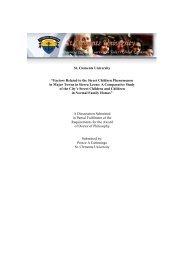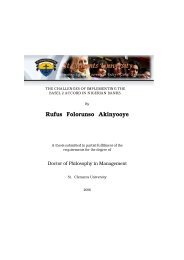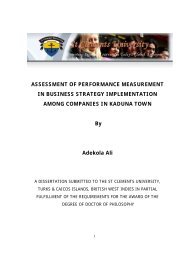The role of informal microfinance institutions in saving
The role of informal microfinance institutions in saving
The role of informal microfinance institutions in saving
Create successful ePaper yourself
Turn your PDF publications into a flip-book with our unique Google optimized e-Paper software.
TABLE 9: Percentage <strong>of</strong> Income and Consumption Received by Lowest 20 percent Households<br />
<strong>in</strong> Tanzania: 1961-1988.<br />
% 1961-64 1965-68 1969-72 1973-76 1977-80 1981-84 1985-88<br />
Percentage <strong>of</strong><br />
Consumption Expenditure<br />
Received by Lowest 20<br />
Percent Households<br />
Percentage <strong>of</strong> Private<br />
Income Received by 20<br />
Percent Households<br />
1.30 3.70 5.72 7.45 9.12 9.20 9.70<br />
2.15 2.09 2.68 4.25 6.50 6.02 5.31<br />
Source: Bank <strong>of</strong> Tanzania (1981): Tanzania, Twenty Years after Independence: 1961-1981., World Bank (Various Issues):<br />
World Development Indicators; and estimates from National Household Budget Surveys (1957/58, 1968/69, 1976/77),<br />
Ramadhani, S (2004); Growth, Income Distribution and the Liv<strong>in</strong>g Standard <strong>of</strong> Average Households <strong>in</strong> Tanzania, PhD <strong>The</strong>sis<br />
Wash<strong>in</strong>gton International University-USA.<br />
(ii)Post 1989 Period<br />
From the economy is characterized by high level <strong>of</strong> unemployment and poor redistributive<br />
policies. Wage <strong>in</strong>crease has been <strong>in</strong> favor <strong>of</strong> the top class rather than <strong>in</strong>creas<strong>in</strong>g the share <strong>of</strong><br />
wages and salaries accrued to lowest class <strong>of</strong> workers. Monetary agriculture <strong>in</strong> the post 1990<br />
has also been decl<strong>in</strong><strong>in</strong>g due lack <strong>of</strong> micro-credits to small scale farmers, poor <strong>in</strong>frastructure,<br />
lower producer prices and high cost <strong>of</strong> <strong>in</strong>puts. Though there has been fats growth <strong>of</strong> <strong><strong>in</strong>formal</strong><br />
sector, it has failed to <strong>in</strong>crease substantially the share <strong>of</strong> <strong>in</strong>come received by the lowest class <strong>of</strong><br />
households <strong>in</strong> the post 1995 period. Further, the poor redistributive policies <strong>in</strong> the post 1990<br />
period have contributed to reduce the share <strong>of</strong> private <strong>in</strong>come and consumption received by<br />
the lowest 20 percent households.<br />
While real GDP <strong>in</strong>creased from an average <strong>of</strong> TZS 945,128.0 millions <strong>in</strong> 1986-89, to an<br />
average <strong>of</strong> TZS 1,239,166.0 MILLIONS IN 1990-93, TZS 1,425,249.2 millions <strong>in</strong> 1994-97; and<br />
TZS 1,621,306.2 millions <strong>in</strong> 1998-2001; the share <strong>of</strong> private <strong>in</strong>come received by the lowest 20<br />
86
















